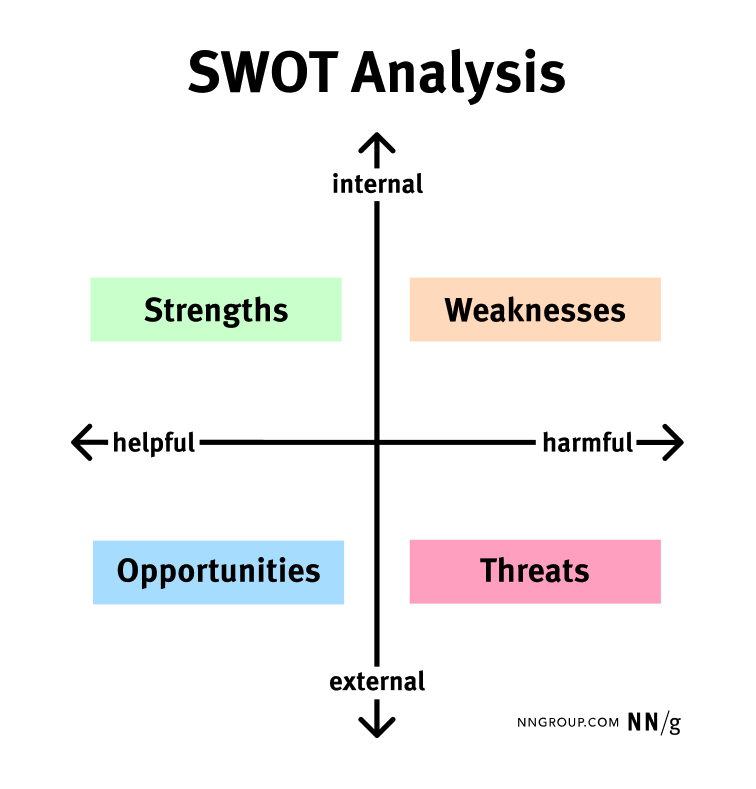Summary:
A SWOT analysis helps teams understand how well a product, service, or organization is positioned in the market to serve its customers.
A company’s ability to survive or thrive will depend not just on meeting user needs but on doing so more effectively than its competitors. This article covers a popular framework that provides a holistic view of both internal knowledge about a company and external insights about competitors: a SWOT analysis.
Definition
A SWOT analysis is a strategic tool to determine how well a product, service, or organization is positioned in the market to serve its customers.
SWOT stands for:
Strengths: advantages unique to the organization or offering
Weaknesses: disadvantages unique to the organization or offering
Opportunities: potentially helpful strategies or practices available to the organization or the offering
Threats: competitors or risk factors that could impact the organization’s or offering’s success
These four categories are typically visualized in a matrix format:
- The x-axis represents how helpful or harmful a factor may be.
- The y-axis represents whether the factor is internal (as in, specific to the organization and its current people and practices) or external.
Example of SWOT Analysis
Let’s take an example to understand how to complete a SWOT matrix. Imagine that a sandwich shop is trying to understand its position in the market. This sandwich shop is quite good at making sandwiches and even has a loyal customer base that visits the shop nearly every day. A SWOT matrix may contain the following information:
|
Strengths |
Weaknesses |
|
|
|
Opportunities |
Threats |
|
|
Based on this information and its appetite for risk, the sandwich shop may decide to make adjustments to its current practices by implementing some of the following changes:
- Reducing costs by choosing seasonal ingredients with longer shelf life or creatively switching to ingredients that can be purchased in bulk
- Growing revenue by encouraging larger purchases or attracting new customers with new offerings
- Improving efficiency by implementing new digital tools that streamline the ordering process or reducing the size of the menu so that ingredients can be used more efficiently
- Reducing employee churn by improving team cohesion or addressing gaps in employee compensation
- Anticipate the future by investing in experimentation efforts (limited-time offers) to address consumers’ long-term health interests and changing tastes
This list obviously does not include every possible strategic direction that the company can take but illustrates how a SWOT analysis helps a team objectively consider a broad range of factors that impact the business.
Benefits of a SWOT Analysis
As the above example demonstrates, a SWOT analysis is a set of prompts meant to help a team make sense of their competitive environment. While any format may suffice for this effort, the SWOT set of prompts helps by:
- Giving clear, well-defined categories that are easy to understand and identify and that can circumvent tense or emotionally driven conversations about the fate of a company or offering
- Mitigating unchecked optimism (or pessimism) about organizational advantages by encouraging a critical lens
- Encouraging introspection to reflect upon internal standards, processes, and resources as key drivers of success
- Supporting contextual awareness of new or emerging trends to help teams anticipate future shifts or obstacles
Fostering more informed discussions about short- and long-term strategic planning and prioritization
Common Pitfalls of a SWOT Analysis
SWOT matrices can be populated by unfounded, superficial, or overly generalized assumptions about customer behavior rather than real, relevant data. This is true regardless of whether the analysis is conducted solo (and subjected to the bias of one person’s assumptions) or collaboratively in a meeting or workshop (and subjected to groupthink or the HiPPO — highest-paid person’s opinion — effect). Further, teams might inadvertently make significant strategic decisions based on assumptions.
A SWOT analysis can be manipulated to make certain strategic proposals more attractive than others by conveniently omitting important factors. If the organization or offering is made to look inordinately strong, then it might be tempting to pursue riskier strategies than are appropriate for the organization’s actual state.
How to Use a SWOT Analysis Effectively
To get the most out of SWOT Analyses, consider the following tips.
Connect objective criteria or tangible examples to each quadrant to ensure the analysis is based on facts, not opinions. Measurable criteria, like usability (SUS), customer loyalty (NPS), satisfaction (CSAT), and employee sentiment (ESAT) can substantiate claims regarding strengths or weaknesses. Survey data or feedback comments can offer insight into unmet needs and opportunities. Other rigorous frameworks like a STEEPLE analysis (social, technological, economic, environmental, political, legal, and ethical factors) can help flesh out secondary research and give context to potential opportunities and threats.
Conduct primary research (behavioral and attitudinal) to get real data on how your competitors actually perform. A brief design review of a competitor’s offering or competitive usability testing can offer insights into competitors’ usability strengths or weaknesses and help fill the threats and opportunities quadrants. These activities can also further reinforce existing knowledge of a company’s strengths or weaknesses.
Create SWOT matrices collaboratively with a crossfunctional or multidisciplinary team to get the most well-rounded assessment of your market position. SWOT analysis is not just a tool for marketing or UX teams — it can also align many parts of an organization when deciding upon key priorities for a long-term vision or roadmap. Additionally, while solo SWOT analyses are popular, they may be a missed opportunity to capitalize on the subject-matter expertise that your team may already have.
Summary
So many internal and external factors can determine whether an organization can successfully pursue certain strategies. Rather than recklessly choosing a new strategic direction based on the latest trending buzzwords, consider using a SWOT analysis as a key step to inform project prioritization.
